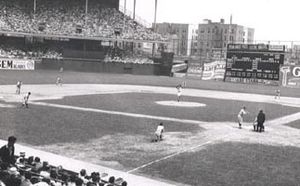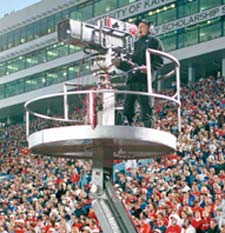Televised sports: Difference between revisions
No edit summary |
m (Text replace - "[[Category:Culture_and_society" to "[[Category:Engineering and society") |
||
| (5 intermediate revisions by 3 users not shown) | |||
| Line 1: | Line 1: | ||
== Televised Sports | == Televised Sports == | ||
[[Image:Sports1.jpg|thumb|right|A still from the first televised broadcast of a professional baseball game in 1939. The Cincinnati Reds are playing the Brooklyn Dodgers. Courtesy: David Sarnoff Library, Princeton, New Jersey. ]] | |||
“Good afternoon, ladies and gentleman. Welcome to the first telecast of a sporting event. I’m not sure what it is we’re doing here, but I certainly hope it turns out well for you people who are watching.” With those words, spoken by sportscaster Bill Stern in 1939 at a baseball game between Princeton and Columbia universities, the incredibly profitable and popular union between sporting events and the then new-fangled invention known as [[Television|television began]] in earnest in the United States. | |||
Today, it is hard to imagine life without televised sports. With twenty-four hour sports channels and year-round coverage, televised sporting events are a huge part of our entertainment. In many homes, they take precedent—despite the occasional protest from less-interested family members—over whatever else may be on television. Sometimes it seems as though television was made solely for the transmission of the latest game, boxing match, or motor race. | |||
In fact, that is truer than one might suspect. The 1936 Olympics, perhaps the very first televised sporting event, were broadcast in host country Germany. But few people had televisions on which to view the games. As more sporting events began being aired in the United States and around the world, however, people began plunking down money so they could see games and events that they formerly had only been able to hear on the radio or read about in the newspaper. <br> | In fact, that is truer than one might suspect. The 1936 Olympics, perhaps the very first televised sporting event, were broadcast in host country Germany. But few people had televisions on which to view the games. As more sporting events began being aired in the United States and around the world, however, people began plunking down money so they could see games and events that they formerly had only been able to hear on the radio or read about in the newspaper. <br> | ||
[[Image:Sports2.jpg|thumb|right|As our appetite for televised sports grew so did the technology used for bringing the game into our homes. ]] | |||
The year 1939 marked the first broadcast of a heavyweight boxing match (Max Baer versus Lou Nova), the first professional baseball game (Cincinnati Reds versus the Brooklyn Dodgers), and the first college football game, (Fordham versus Waynesburg). 1940 saw the first televised hockey and basketball games. The next year close to 150,000 viewers tuned in to watch the first televised heavyweight title fight between Joe Louis and Billy Conn. The first televised World Series game (New York Yankees versus the Brooklyn Dodgers) aired in 1947 and attracted an amazing-for-the-time 3.9 million viewers. A year later professional wrestling made its television debut. | |||
Televised sports grew so quickly that by 1967 a huge audience watched the Green Bay Packers defeat the Kansas City Chiefs in the first Super Bowl. With that began a new cultural tradition in the United States—Super Bowl Sunday—which is a veritable holiday. Worldwide viewership of the 2002 Super Bowl was estimated to be 800,000,000 people. Audiences for other sports such as soccer can be even higher. Estimates for World Cup matches are over one billion people! | Televised sports grew so quickly that by 1967 a huge audience watched the Green Bay Packers defeat the Kansas City Chiefs in the first Super Bowl. With that began a new cultural tradition in the United States—Super Bowl Sunday—which is a veritable holiday. Worldwide viewership of the 2002 Super Bowl was estimated to be 800,000,000 people. Audiences for other sports such as soccer can be even higher. Estimates for World Cup matches are over one billion people! | ||
| Line 21: | Line 17: | ||
The near insatiable desire for sports programming led to ratings giants such as Monday Night Football, which was launched in 1970. All sports cable stations soon followed. The United State’s ESPN was launched in 1979 and was followed five years later by the Canadian network TSN. | The near insatiable desire for sports programming led to ratings giants such as Monday Night Football, which was launched in 1970. All sports cable stations soon followed. The United State’s ESPN was launched in 1979 and was followed five years later by the Canadian network TSN. | ||
From their inception televised sports ruled the airwaves. But was the goal of the networks and the television stations to provide a public service, by bringing people sporting events they would otherwise miss? Perhaps. Yet the allure of making vast amounts of money can’t be ignored. Television was recognized early on as a useful tool for advertisers to reach large amounts of people. But first viewers had to be compelled to purchase televisions and then watch them. Televised sports proved to be a huge success among audiences. Although few could have foreseen how perfectly the union of television and sports would work, think about how many millions of dollars are spent on just seconds of Super Bowl advertising. That money, given to the network, makes televising sporting events very lucrative. But there is a cost to the network as well. High ratings of sports allows team owners and sports leagues (such as the NFL, NBA, etc.) to charge large sums of money for broadcasting rights to their games. The result? Millionaire sports superstars. | From their inception televised sports ruled the airwaves. But was the goal of the networks and the television stations to provide a public service, by bringing people sporting events they would otherwise miss? Perhaps. Yet the allure of making vast amounts of money can’t be ignored. Television was recognized early on as a useful tool for advertisers to reach large amounts of people. But first viewers had to be compelled to purchase televisions and then watch them. Televised sports proved to be a huge success among audiences. Although few could have foreseen how perfectly the union of television and sports would work, think about how many millions of dollars are spent on just seconds of Super Bowl advertising. That money, given to the network, makes televising sporting events very lucrative. But there is a cost to the network as well. High ratings of sports allows team owners and sports leagues (such as the NFL, NBA, etc.) to charge large sums of money for broadcasting rights to their games. The result? Millionaire sports superstars. | ||
[[Category:Communications]] [[Category:TV]] | [[Category:Communications]] | ||
[[Category:Broadcasting]] | |||
[[Category:TV_broadcasting]] | |||
[[Category:TV]] | |||
[[Category:Engineering and society]] | |||
[[Category:Leisure]] | |||
[[Category:Leisure]] | |||
[[Category:News]] | |||
Revision as of 16:46, 22 July 2014
Televised Sports
“Good afternoon, ladies and gentleman. Welcome to the first telecast of a sporting event. I’m not sure what it is we’re doing here, but I certainly hope it turns out well for you people who are watching.” With those words, spoken by sportscaster Bill Stern in 1939 at a baseball game between Princeton and Columbia universities, the incredibly profitable and popular union between sporting events and the then new-fangled invention known as television began in earnest in the United States.
Today, it is hard to imagine life without televised sports. With twenty-four hour sports channels and year-round coverage, televised sporting events are a huge part of our entertainment. In many homes, they take precedent—despite the occasional protest from less-interested family members—over whatever else may be on television. Sometimes it seems as though television was made solely for the transmission of the latest game, boxing match, or motor race.
In fact, that is truer than one might suspect. The 1936 Olympics, perhaps the very first televised sporting event, were broadcast in host country Germany. But few people had televisions on which to view the games. As more sporting events began being aired in the United States and around the world, however, people began plunking down money so they could see games and events that they formerly had only been able to hear on the radio or read about in the newspaper.
The year 1939 marked the first broadcast of a heavyweight boxing match (Max Baer versus Lou Nova), the first professional baseball game (Cincinnati Reds versus the Brooklyn Dodgers), and the first college football game, (Fordham versus Waynesburg). 1940 saw the first televised hockey and basketball games. The next year close to 150,000 viewers tuned in to watch the first televised heavyweight title fight between Joe Louis and Billy Conn. The first televised World Series game (New York Yankees versus the Brooklyn Dodgers) aired in 1947 and attracted an amazing-for-the-time 3.9 million viewers. A year later professional wrestling made its television debut.
Televised sports grew so quickly that by 1967 a huge audience watched the Green Bay Packers defeat the Kansas City Chiefs in the first Super Bowl. With that began a new cultural tradition in the United States—Super Bowl Sunday—which is a veritable holiday. Worldwide viewership of the 2002 Super Bowl was estimated to be 800,000,000 people. Audiences for other sports such as soccer can be even higher. Estimates for World Cup matches are over one billion people!
The near insatiable desire for sports programming led to ratings giants such as Monday Night Football, which was launched in 1970. All sports cable stations soon followed. The United State’s ESPN was launched in 1979 and was followed five years later by the Canadian network TSN.
From their inception televised sports ruled the airwaves. But was the goal of the networks and the television stations to provide a public service, by bringing people sporting events they would otherwise miss? Perhaps. Yet the allure of making vast amounts of money can’t be ignored. Television was recognized early on as a useful tool for advertisers to reach large amounts of people. But first viewers had to be compelled to purchase televisions and then watch them. Televised sports proved to be a huge success among audiences. Although few could have foreseen how perfectly the union of television and sports would work, think about how many millions of dollars are spent on just seconds of Super Bowl advertising. That money, given to the network, makes televising sporting events very lucrative. But there is a cost to the network as well. High ratings of sports allows team owners and sports leagues (such as the NFL, NBA, etc.) to charge large sums of money for broadcasting rights to their games. The result? Millionaire sports superstars.

